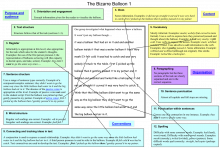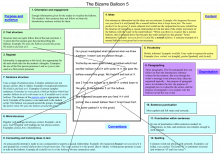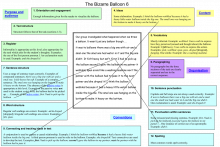Balloon throwing I
This task can completed with pencil and paper or online.
Equipment
The students must have recently done the science activity Throwing Balloons 2. The students should use their POE sheets from that activity to prompt their memories as they do this writing task. [You may need to refresh the students' memories of the science activity before they begin this task by discussing the science activity and the POE sheets.] Some students will find the task difficult to read. They may also find it difficult to carry out because they are asked to do not just one but three things:
- Describe the balloon.
- Describe what happened when the balloon was thrown.
- Explain why the balloon moved the way it did.
Your judgement will determine to what extent you scaffold the task. The following are suggestions only. They give clarification and reminders about the writing side of the task but do not attempt to direct the students' science thinking:
- Read the task to your students and encourage them to seek clarification from you whenever they need to.
- Explain that "bizarre" means strange or unusual.
- Read the introductory sentence of The Bizarre Balloon and explain that the beginning of their writing has been done for them to make it easier to start.
- Give frequent verbal reminders - for example, "When you write about what happened when you threw the balloon, remember to get the order right. Tell what happened first, then remember what happened when _______ threw the balloon."
- Ask the students to do each section (1-3) together, one section at a time. This way, you can focus your reminders on one section only (unfortunately, this approach will mean they will not be able to work at their own pace).
Finally, below are some additional prompts you could use with students:
Section 1:
Describe the balloon. What did it look like? What did it feel like? Give the reader enough information so that they can imagine what it looked and felt like.
Section 2:
Describe what happened when the balloon was thrown.
- Use words that describe the action (what the balloon did/how it moved).
- Write about the action in the correct order.
- Use words that help you describe the order things happened in - for example, "first," "then", "next", "finally", "after", "following", "at the same time".
- Write about more than one way that the balloon moved.
Section 3:
Explain why you think the balloon moved the way it did.
- Use words that describe the action (what the balloon did).
- Write about the action in the correct order.
- Use words that help you explain what caused the balloon to move the way it did - for example, "because", "so", "if", "then", "since".
- Write about more than one possible explanation.
You could also prompt students to use paragraphs but their use is not expected at this level.
Literacy Learning Progressions (Writing)
Because this assessment task was trialled with Year 3 students in the second half of the year, the most relevant progression is After three years at school. You may also find adjacent progressions helpful when you analyse your student data: After two years at school and By the end of Year 4. We have not listed the most relevant bullet points because the assessment criteria used to analyse the student writing cover a broad range; therefore, almost every bullet point at Year 3 is relevant.
Links to Science
This task models writing in support of the Science learning area. At level 2 in science, students should be able to describe simple patterns and observations; give personal explanations; and build language that supports descriptions and observations.
This task exemplifies how you might foreground "Using language, symbols, and texts" and, to a lesser extent, "Thinking" within writing through a focus on the way writers construct texts for particular purposes by the use of carefully chosen details. In this case the purpose is to describe and explain within a science context. Therefore, the text details will include the grammatical structures and vocabulary specific to explaining and describing and, to a small extent because of the age of the students, to the science curriculum area. In the table below, "Using language, symbols, and texts" has the largest bolded font because it is the most important to this task.

Annotated exemplars
This resource was trialled by 19 students from one Year 3 class in a decile 10 school.
The following student scripts were produced from the trial of the task. They have been assessed against 12 criteria which are explained in the Writing Assessment Guide, and annotated accordingly. The student scripts are first drafts.
The Bizarre Balloon 1
Sentence punctuation: Use texts that have no sentence punctuation, e.g., texts published online – delete full stops and edit sentence capitals. Ask the student to read the text aloud and to listen for groups of words that make ideas/make sense together. Ask them to identify where those ideas begin and end. Finally, ask them to edit their Bizarre Balloon script.
The Bizarre Balloon 2
Ideas: Give the student sentence starters that show how the reason comes after the conjunction "because" in a causal relationship, e.g., "I like hamburgers because ...". Finally, support them to re-write their explanation of why they think the balloon moved the way it did.
The Bizarre Balloon 3
Connecting and tracking ideas in text: Ask the student to read their script aloud from "I think ... " onwards. Ask them to put in a full stop where the first idea ends (i.e., after biregshons). Start the next sentence for the student with "This happened because ..." and support them to finish their explanation (it may be necessary to also work on the next step outlined above for Bizarre Balloon 2).
The Bizarre Balloon 4
Paragraphing and Punctuation within sentences: Ask the student to independently return to the task and to check that each section has its own paragraph and that capital letters have been used correctly.
The Bizarre Balloon 5
Ideas: Give the student sentence starters that show that the first step is to describe what happened and the second step is to use the conjunction "because" to link what happened with the reason for why it happened, e.g., "The car crashed into the tree because ...". Finally, support them to re-write their explanation of why they think the balloon moved the way it did.
The Bizarre Balloon 6
Sentence punctuation: Use texts that have no sentence punctuation, e.g., texts published online – delete full stops and edit sentence capitals. Ask the student to read aloud and to listen for groups of words that make ideas/make sense together. Ask them to identify where those ideas begin and end. Finally, ask them to edit their Bizarre Balloon script.
Punctuation within sentences: It may also be useful to work on commas. Begin with commas used in lists, e.g., "First I have a shower, then I get dressed, brush my hair, have my breakfast, brush my teeth, and then I'm off to school." Give the student sentences that include lists and support them to put in the commas.







